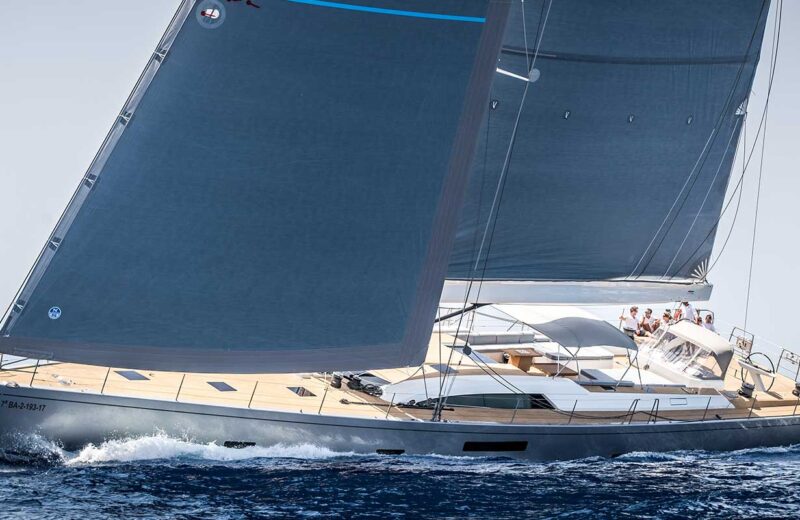Flagship: Will younger owners enjoy ‘the wind’s song’?

“And all I ask is a tall ship and a star to steer her by”
There’s no better evocation of the joys of life under sail than John Masefield’s classic poem Sea-fever. But is the alure of sailing life lost on younger generations of superyacht investors?
Are the comforts (and luxurious space) offered by motor cruisers increasingly putting sailing vessels in their wind shadow? Or are younger investors, impressed by sail’s green credentials, more likely to catch sailing sea fever than their older counterparts? To gauge the strength of the economic winds powering the market Superyacht Investor canvassed industry views.
We begin with research from SuperYacht Times. It describes 2020, the latest year for which data is available, as “extremely slow” for new sailing yacht sales, with only five new yachts sold compared with 10 in 2019. Part of the reason was the global pandemic, with the nature of sailing yacht construction making the sector particularly vulnerable. “This process requires very active involvement from the client: something which may have been difficult during the Covid-19 pandemic,” according to the title. Sailing yacht projects are usually commissioned by a client, and speculation projects are still rare. Only one or two speculation projects are sold each year, while the remaining projects are commissioned.
“Over 25% of the new sailing yacht sales during the past decade concerned yachts which were built to a model, with Southern Wind, Nautor’s Swan and Perini Navi accounting for the lion’s share of these sales,” reveals SuperYacht Times research. “However, it is also interesting to note that four yachts built to the Truly Classic 128 design by Hoek Design have been completed at three different yards since 2015.”
Last year sales exceeded the 2020 total and shipyards building to a model “seem to have the upper hand for now”.
Baltic Yachts, executive vice president Henry Hawkins is optimistic about the prospects for sailing yacht sales. “It is a buoyant market right now with an increased number of first-time buyers and in general a younger profile,” Hawkins tells Superyacht Investor (SYI).
Sailing yachts offer owners the opportunity for closer interaction with the sea and marine environment, he continues. “They offer a romanticism often missing from the power boat sector. Plus, a platform for exploration, which often seems to be overlooked when discussing super sailing yachts. Several of our boats have spent considerable time off the beaten track.”
Most large sailing yachts under construction will have a reduced environmental impact compared with their motor yacht counter parts and are, by their nature, set up for exploration. “We don’t need to call them explorer yachts. They offer an intimate platform with close proximity to the sea and nature that is very attractive to prospective owners,” says Hawkins.
The pandemic proved a turning point, according to Chris Sherlock, Doyle Sails Spain, MD. “Before Covid, the sector was slowing down considerably after a healthy period. Since Covid, sailing yacht yard manufacturers are all full until well into 2024/25 and it doesn’t look like slowing down any time soon,” he tells SYI. After the pandemic restrictions were lifted, many high-net worth individuals realised the safest place for family and friends to holiday was aboard a yacht.
But not everyone shares unbridled enthusiasm for life under sail. Pepe García-Aubert, president & CEO of superyacht refit and repair specialist MB92 Group believes there has been a big fall in the ratio of sailing superyachts to motor cruisers. “We do refit sailing yachts but the ratio of sailing yachts to motor yachts is very poor – one to 10,” García-Aubert tells SYI. “And it’s definitely worsened in recent years. “For the size of a good sailboat you can have very much more capacity in a motorboat.”
His colleague Ben Mennem, CEO of MB92 La Ciotat, based in southern France, also sees inherent limitations in the design and operation of sailing vessels. “New owners don’t normally want the inconvenience of sailing. It’s generally not that comfortable when you are heeled over and the wind is not a given.” Plus, owners and guests cannot enjoy the same level of privacy, due to the reduced number of decks, and fewer tenders can be carried, he adds.
García-Aubert also questions the appeal of sailing vessels to younger investors. “The younger generation don’t seem to have taken sail boats on.”
It’s not a picture recognised by Hawkins of Baltic Yachts. He detects increasing recognition, particularly from younger generations, of the reduced environmental impact of sailing vessels. “We see increasing awareness of the environment and the footprint of the yacht upon it,” he says. “This has led to a move towards electric drives, solar panels, teak deck alternatives and an awareness of overall power consumption. In the coming years we can expect to see increasing scrutiny from clients as to how we conduct ourselves and our respect for the environment and each other.”
Hawkins also disputes the idea that sailing superyachts are inherently less comfortable than their motor-powered counterparts. “Demand for increased comfort levels has also seen large steps forward in terms of noise and vibration technology, air treatment plants, etc which will continue into the future,” he says. “The request for increased performance never seems to diminish and with the push to more sustainable solutions, light weight solutions remain a priority for many clients.”
Also, as the size of yachts has increased the provision of an inside/outside connected living space has come to the fore, he argues. “So, there is same level of cockpit and saloon plus the desire for increased sun protection in yachts such as Baltic 112, Liara, Baltic 142, Canova and Baltic 146 Path.”
The development of hybrid propulsion will further add to the appeal of sailing vessels. “By their very design, sailing yacht hulls are more easily pushed through the water than their motor yacht counter parts; therefore requiring less power. Electric propulsion opens the door for hydro regeneration when under sail,” according to Hawkins.
Sherlock, at Doyle Sails Spain, shares his enthusiasm for hybrid propulsion. “It will be a game changer thanks to what is being worked on now and being installed in large sailing yachts in the very near future,” says Sherlock. But the new hybrid technology and hydro power plants generated through sailing are available now. “We can now roughly sail one hour for every 10 hours on anchor as a ratio. So depending on battery banks to store the power, it is becoming a very efficient way of not using fossil fuels.”
The benefits of new technologies on very large sailing superyachts will become increasingly clear to eco-aware investors over the next three to five years. “Sailing yachts are so much more environmentally friendly and the new wave of owners will want to be a part of it.”
These arguments are not lost on the unnamed owner of a new sailing yacht under construction at Southern Wind’s Cape Town shipyard. The first hull in its 35m (115ft) SW108 Hybrid series, the custom yacht’s exterior and interior design is by Nauta Design with naval architecture by Farr Yacht Design. There will be accommodation for eight, including the owner’s cabin forward and three guest cabins amidships. Plus a social area and dining area forward of the main saloon. Delivery is set for early summer next year.
While the new owner’s identity has not been revealed, Southern Wind describes him or her as “a young and passionate sailor”.
Meanwhile, let’s close with a reminder of the thrill of sail, courtesy of the opening stanza of Masefield’s Sea-fever, first published in 1915.
“I must go down to the seas again, to the lonely sea and the sky,
And all I ask is a tall ship and a star to steer her by;
And the wheel’s kick and the wind’s song and the white sail’s shaking,
And a grey mist on the sea’s face, and a grey dawn breaking.”
Reader’s comment
“Another interesting read, thank you.
All of this does not consider a yacht like Black Pearl, which has the volume of an 80m motor yacht, carries just as many toys, has a speed so far up to 24 knots under sail, sails 84% of the time at a usual speed of 12 to 14 knots and costs a tenth of the cost to run.
Bespoke sailing yachts can carry as much as a good-sized motor yacht.
They ‘might’ cost more to build but, if designed correctly, definitely cost far less to operate.”
Derek Munro
Director/yacht manager

